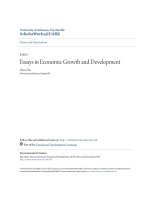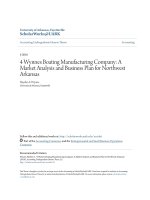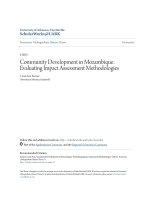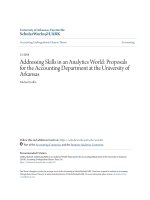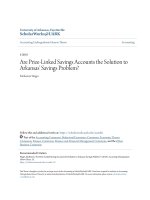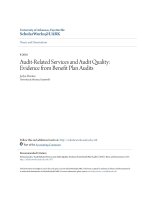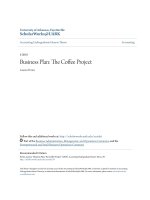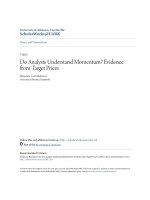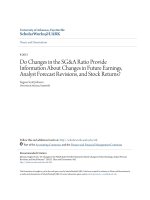Accounting undergraduate Honors theses: Labor force commute mode preferences and the natural environment
Bạn đang xem bản rút gọn của tài liệu. Xem và tải ngay bản đầy đủ của tài liệu tại đây (347.67 KB, 44 trang )
University of Arkansas, Fayetteville
ScholarWorks@UARK
Accounting Undergraduate Honors Theses
Accounting
5-2015
Labor Force Commute Mode Preferences and the
Natural Environment
Brandon Killen
University of Arkansas, Fayetteville
Follow this and additional works at: />Part of the Business Administration, Management, and Operations Commons
Recommended Citation
Killen, Brandon, "Labor Force Commute Mode Preferences and the Natural Environment" (2015). Accounting Undergraduate Honors
Theses. 16.
/>
This Thesis is brought to you for free and open access by the Accounting at ScholarWorks@UARK. It has been accepted for inclusion in Accounting
Undergraduate Honors Theses by an authorized administrator of ScholarWorks@UARK. For more information, please contact ,
Labor Force Commute Mode Preferences and the Natural Environment
By
Brandon Killen
Advisor: Susan E. Bristow
An Honors Thesis in partial fulfillment of the requirements for the degree Bachelor of
Science in Business Administration in Accounting
Sam M. Walton College of Business
University of Arkansas
Fayetteville, Arkansas
December 11, 2014
Abstract
In commuting to work, commuters select from a limited variety of transportation modes,
including alternative modes like cycling and walking, based on needs and preferences.
Understanding these needs and preferences, and how the conditions of the immediate
environment can influence them can benefit both businesses and local governments in their
efforts to accommodate the commute needs of their workers and better serve their communities.
Though the body of commute preference research has grown significantly over recent decades,
the study of the effects of the natural environment has remained mostly overlooked. In my
research, I examined the relationships between selected weather conditions of the natural
environment and the percentage of the labor force that cycled or walked to work in large U.S.
cities.
To explore these relationships, I employed multicollinaerity and multiple linear
regression analysis of the percentage of the labor force that commuted by cycling or walking in
the two largest cities of each state with eight observed conditions of the natural environment in
each city: the mean daily maximum temperature; the mean daily minimum temperature; the
number of days per year in which fog limited visibility to less than or equal to one-quarter mile;
the number of days per year with thunderstorms; the mean wind speed; the total water equivalent
precipitation; the total amount of snow, ice, pellets, and hail; and the total number of days with
snowfall greater than or equal to one inch.
The results of my statistical analysis revealed that only two variables (the number of days
per year with thunderstorms and the total water equivalent precipitation) exhibited significant
relationships with the percentage of work commuters who cycled or walked. Furthermore, the
number of days per year with thunderstorms exhibited a strong inverse relationship, meaning that
thunderstorms deterred workers from cycling or walking to work. These relationships confirmed
the significant influence that precipitation, as a condition of the natural environment, can bear on
commute preferences. Based on these findings, businesses can better understand their employees
and improve their productivity and reputations within their communities by accommodating the
differences in commute mode preferences across varying climatological regions.
Acknowledgments
Throughout the completion of my honors thesis, I met and received invaluable guidance
and assistance from a collection of knowledgeable individuals within the faculty of the Sam M.
Walton College of Business and the University of Arkansas Library. First, I would like to
express my appreciation to Dr. Susan Bristow for her commitment and continual encouragement
as my thesis advisor. With her counsel, I developed exponentially my research acumen, and
gained substantial experience in the process. Additionally, I would like to thank JaLynn Thomas
for her auxiliary perusal and consideration of my research.
For their considerable assistance during the preliminary diagnostics and statistical
analysis procedures of my methodology, I would like to thank Dr. Christina Serrano and Ruba
Aljafari. I would also like to thank Mark Minton of the Walton College Writing Center for
offering additional guidance in the writing of my research. Finally, I would like to express my
gratitude to Donna Daniels of the University of Arkansas Library for providing me with
numerous resources which, in turn, provided momentum in the completion of my literature
review. As a former data analysis and scholastic research novice, I have a sincere and deep
appreciation for all of the enthusiastic and considerate experts to whom I have been introduced
throughout this process.
Table of Contents
Introduction ..........................................................................................................................6
Literature Review.................................................................................................................8
History of Commute ................................................................................................8
Current Research on Work Commute ......................................................................9
Driving ...................................................................................................................10
Carpooling..............................................................................................................11
Cycling ...................................................................................................................12
Determinants of Commute Mode Preference ........................................................13
Health and the Benefits of Alternative Commute Modes ......................................14
The Built Environment and Its Effects on Commute.............................................16
The Natural Environment ......................................................................................17
Business Perspectives and Responses ....................................................................18
Description of Research .....................................................................................................20
Hypothesis..............................................................................................................20
Data and Methodology...........................................................................................21
Statistical Analysis .................................................................................................22
Results of Research ............................................................................................................29
Discussion of Research ......................................................................................................34
Summary ................................................................................................................34
Limitations of Methodology ..................................................................................35
Implications............................................................................................................36
Future Research .....................................................................................................37
Bibliography ......................................................................................................................39
Introduction
Workers select from a limited variety of transportation modes to decide how they will
commute to their places of work every day. Though the automobile is often the sole practical
option for long-distance work commuters, modes such as walking and cycling provide
alternatives for those with different commute needs and preferences. Understanding these needs
and preferences, particularly how they interact with the various conditions of the immediate
environment, is crucial not only for infrastructural and urban planning in cities with large
populations, but for businesses seeking to assimilate into their environments and intuitively
attract and retain employees as well. I elected to research the relationship between the share of
the labor force that commuted by walking or cycling with the conditions of the natural
environment in large cities throughout the United States to better understand commuter
preferences and discover ways to benefit businesses’ interactions with their employees and host
communities in different climatological regions.
The advent of the information age, in concurrence with the current trend of increasing
globalization, warrants that businesses adopt more intuitive approaches to not only recognize, but
better satisfy non-financial stakeholders like host communities, local governments, customers,
and particularly employees. Information about worker preferences and a holistic understanding
of a firm’s immediate surroundings provide opportunities for the firm to improve hiring and
retention, and strengthen its reputation. Understanding the interactions between the conditions of
the natural environment and labor force preferences provides just such activities for businesses
operating throughout the various climatological regions of the United States.
Examining commute mode preferences cannot be accomplished with a singular focus, but
instead requires a multi-faceted approach that considers all relevant conditions. With my
6
research, I seek to explore the mostly overlooked effects of the natural environment and
contribute to a growing abundance of research in the broader study of work commute
preferences. This thesis attempts to review the existent research of work commute preferences,
define the relationship between work commute preferences and the natural environment, and
provide insights that will aid businesses in responding to their environmental conditions,
accommodating their employees and communities, and improving their financial performance.
7
Literature Review
History of Commute
In the late 19th century, private developers with extensive, but sprawled real estate
holdings created America’s first transit-oriented communities by constructing trolley lines that
reached from more densely populated areas to the significantly less-populated outskirts (Cervero,
1996). These “streetcar suburbs” laid the foundation for the emergence of the American suburb
in the 1940s and its explosive growth in tandem with the major postwar infrastructure
developments of the 1950s and 1960s. The steady decentralization of concentrated metropolitan
areas to low-density suburbs dispersed large populations and, therefore, increased the travel
distances between homes and frequented destinations (Committee, 2005). As a result, the private
automobile became the primary mode of transport for residents of suburbs.
Despite the continued dominance of the private automobile as a transport mode,
alternative modes have achieved moderate success and gained considerable legitimacy over the
past 60 years. Carpooling first emerged in U.S. policy during World War II, in the midst of
national oil and rubber shortages, and reappeared in public policy as a response to growing
shortages during the OPEC oil crisis in the mid-1970s (Ferguson, 1997). As a major form of
commute, cycling emerged in city planning in the 1970s and has since experienced renewed
interest in public policy and rising popularity beginning in the mid-to-late 1990s with the
construction of expansive new, interconnected bicycle infrastructure, including bike paths and
street lanes (Buehler, Hamre, Sonenklar, & Goger, 2011a; Buehler & Pucher, 2011b). The
population cycling to work increased by 60% over the last decade alone, though the current size
is merely 786,000 people. In addition, walking to work has recovered from a decline in
popularity in the 1990s and stabilized at a mere 3% (Tracy, 2014).
8
These modest successes in alternative modes of transportation, though promising areas
for development in the coming decades, are minuscule in comparison to the trend of increasing
single-person car drivers. Between 1970 and 1990, the population driving alone increased while
carpooling decreased, and since 1980, the number of miles that Americans drive has grown three
times faster than the U.S. population (DeLoach & Tiemann, 2010; Ewing, Bartholomew,
Winkelman, Walters, & Chen). These findings corroborate the trend of accelerating
suburbanization of populations and jobs throughout the 1990s, and the current dominance of
driving alone over carpooling, public transit, cycling, walking, and other modes of transport
(Lawson, 1997).
Current Research on Work Commute
Modern research has employed U.S. Census data and American Community Survey
findings to explore new subject areas with the potential for discussion in public policy, such as
the national distribution and international comparisons of commute preferences. According to an
analysis by McKenzie & Rapino (2011) of the 2009 American Community Survey, over threefourths of the American labor force drove to work alone with an average trip duration of 25.1
minutes. In examining the distribution by commute mode of the U.S. labor force, this study also
confirms the dominance of driving personal vehicles (86.1%) and, more specifically, driving
alone as a mode of transport (76.1%), and provides insight into the gradual growth of alternative
transportation modes. These findings confirm the analysis of data from the 2000 U.S. Census by
Handy, Boarnet, Ewing, & Killingsworth (2002), in which 86.5% of all commute trips were in
personal vehicles, 5.3% were on public transit, and 3.9% were walking. Modern research on the
9
national distribution of commute preferences corroborates the already significant, yet growing
gap between personal vehicle trips and alternative modes identified throughout previous decades.
Aside from analysis of trends in the United States, modern research has also addressed
the differences in commute mode preference between developed nations collecting demographic
data comparable in both scope and validity. European studies have noted the stark contrast
between European and American commute preferences and explored the health effects of routine
travel (Audrey, Procter, & Cooper, 2014; Buehler, Pucher, Merom, & Bauman, 2011c;
Gottholmseder, Nowotny, Pruckner, & Theurl, 2008; von Huth Smith, Borch-Johnsen, &
Jørgensen, 2007). In a study comparing the United States with Germany, researchers found that
Europeans employ walking, cycling, and public transit significantly more than Americans,
averaging more than twice as many walk trips per day as Americans (Buehler, Pucher, Merom, et
al., 2011c). In addition, the increases in frequency, duration, and distance of walk and bicycle
trips per capita between 2001/2002 and 2008/2009 were much larger in Germany than in the
U.S. Other European studies detail the effects of work commute on stress perception, the
favorable relationship between commuting physical activity and biological risk factors for
cardiovascular disease, and the overall health benefits of walking to work (Audrey et al., 2014;
Gottholmseder et al., 2008; von Huth Smith et al., 2007).
Driving
The share of commuters driving private vehicles to work and other desired destinations
significantly dwarfs all other modes of transportation despite yearly increases in gas prices
(Lipman, 2006). Between 1980 and 1990, the share of work trips made by people driving alone
in private vehicles increased from 64.4% to 73.2%, and reached 76.1% in 2011 (Cervero, 1996;
10
McKenzie & Rapino, 2011). In addition, a 2006 study found that more than 85% of low-tomoderate income workers in the United States drove to work in private vehicles (Lipman, 2006).
Many studies have emerged throughout the past three decades to explain the preeminence
of private vehicle drivers and connect these statistics with population settlement trends,
economic conditions, and psychology and sociology (Cassidy, 1992; Evans, Wener, & Phillips,
2002; Gottholmseder et al., 2008; Lawson, 1997; Lee, Gordon, Richardson, & Moore, 2009;
Lipman, 2006). In accordance with the accelerating suburbanization that occurred during the
second half of the 20th century, driving has increased to allow workers to commute to job centers
distant from their homes (Lawson, 1997; Lipman, 2006). Others point to strong income growth
during the late 1990s and the general affordability of private vehicles for regular work and
leisure trips (Lawson, 1997; Lee et al., 2009). And, in contrast to common conceptions of “road
rage” and perceived stress associated with driving, a study by Cassidy (1992) reported that car
users had more positive travel experiences than those taking public transit. This positive
experience is suggested to be a manifestation of greater control, which was shown to influence
stress perception be positively correlated with lower stress, hostility, and blood pressure
(Cassidy, 1992; Evans et al., 2002; Gottholmseder et al., 2008).
Carpooling
Though carpooling emerged in U.S. policy during the 1940s, the first major publications
on carpooling appeared in the late 1970s as the share of commuters driving with others declined
(Ferguson, 1997). Carpooling, like other alternative modes of transportation, has consistently
declined over the past 50 years. However, a reversal in the long-run trend of decline in
carpooling occurred during 2005-2010 when the number of commuters sharing vehicles
11
increased slightly. To explain this anomaly, Ferguson (1997) points to the relatively recent
advent of “ride-sharing” programs, the openings of new rapid transit systems, the increased
demand for public transit, and rising gasoline prices. A 2010 study shows that carpooling
exhibits a relatively large elasticity in relation to gas prices (DeLoach & Tiemann, 2010). These
findings support the economic theory that increases in commuting time and the cost of gasoline
decrease the likelihood of driving alone.
Cycling
Though the share of work commuters cycling is relatively minuscule, it has increased
exponentially throughout the past two decades and has become an initiative for public policy
across the world (Buehler, Hamre, et al., 2011a; Buehler & Pucher, 2011b; Tracy, 2014). The
population of commuters cycling to work across the United States increased from 488,000 in the
2000 U.S. Census to 786,000 in the 2008-2012 American Community Survey – a greater than
60% increase in a single decade (Tracy, 2014). This nationwide increase is attributed to the
“renaissance” in bicycle planning that occurred in the late 1990s, as cities increased the volume
of cycling infrastructure and modified the local urban design to seem safer and more bicyclefriendly (Buehler, Hamre, et al., 2011a). Over the past two decades, Washington, D.C. has
expanded its bicycle infrastructure dramatically and has experimented with new infrastructure
innovations. Traffic lights for cyclists, bicycle boxes, contra-flow bicycle lanes, and Bikeshare –
the nation’s first regional bicycle sharing program – are only a few of the improvements
implemented in the D.C. region.
Recent research has confirmed the utility of these increases in bicycle infrastructure, both
in the D.C. area and across the nation (Buehler, Hamre, et al., 2011a; Buehler & Pucher, 2011b).
12
Cities, like Washington, D.C., with a greater supply of bicycle paths and lanes, safer cycling, less
sprawl, less car ownership, and higher gasoline prices exhibit more cycling than automobileoriented cities (Buehler & Pucher, 2011b). However, improvements in bicycle infrastructure
have been found to be beneficial at both the municipal level and the private business level
(Buehler, Hamre, et al., 2011a). Businesses offering bicycle parking, clothes lockers, and cyclist
showers at work are associated with more cycling. In addition, businesses offering free car
parking with work are associated with less cycling. Such results have encouraged public policy
increasingly to support bicycle infrastructure.
According to Tracy (2014), “the logic behind the [cycling] push is that government
cannot continue building roads indefinitely,” especially considering that additional lanes on
roadways provide, “only temporary relief from congestion,” (p. 1). While traditional thought
would propose increases in roadway volume to combat growing traffic congestion, recent
research has shown that increased cycling is associated with higher population density, closer
proximities to work and other destinations, and increased interconnectivity of the existent bicycle
infrastructure (Buehler, Hamre, et al., 2011a). Understanding the environmental conditions that
encourage cycling, as well as the psychological causes that lead commuters to cycle, will be key
to addressing future traffic congestion in public policy.
Determinants of Commute Mode Preference
Analysis of the factors which determine whether an individual commutes by vehicle,
public transit, bicycle, walking, or other means is of equal importance to commute research as
current trends. Perhaps the most obvious determinant of commute mode is monetary cost. A
2006 study by the U.S. Center for Housing Policy found that housing and transportation costs are
13
rising at rates faster than those of incomes (Lipman, 2006). This proves especially problematic
because housing (28%) and transportation (29%) are the two largest expenses for most
households in 28 observed metropolitan areas.
Aside from basic economics, psychological factors and perceived convenience have been
examined as significant determinants (Adams, 2010; Heinen, Maat, & van Wee, 2011). A 2011
study conducted in the Netherlands considered the attitudes and psychological factors that impact
bicycle commuters and found that perceived environmental benefits, physical exercise, and
flexibility were significant contributors (Heinen et al., 2011). In addition, researchers pointed to,
“time, comfort, and flexibility,” as the bases for the decisions of commuter cyclists. A similar
study examined the perceived barriers to walking to and from work, and found that 31.4% of
reported barriers were associated with the perceived convenience of using a car instead (Adams,
2010). In making decisions about how they get to work, commuters are affected by both
financial and psychological factors.
Health and the Benefits of Alternative Commute Modes
The World Health Organization (WHO) estimates that 60-80% of the world’s population
does not meet the recommendations required to induce health benefits (WHO, 2007). In the
United States, the Surgeon General recommends daily physical activity of greater than or equal
to 30 minutes continuously or intermittently (Centers for Disease Control and Prevention, 1996;
Ham, Yore, Fulton, & Kohl, 2004). In a 2005 study by the Committee on Physical Activity,
Health, Transportation, and Land Use, researchers found that a full 55% of the U.S. adult
population fails to meet these federal guidelines, and that 25% of respondents were completely
inactive when not at work (Committee, 2005). Such large-scale inactivity directly resulted in
14
medical expenses of more than $76 billion in 2000. Although there may be more serious health
implications, given the observed relationship between physical inactivity and the risks of
cardiovascular disease and mortality (von Huth Smith et al., 2007).
The first U.S. Surgeon General report on Physical Activity and Health, issued in 1996,
was the first report to document the well-established causal connection between physical activity
and health (Committee, 2005). Since then, regular moderate physical activity has been proven to
reduce the risks of numerous chronic diseases, obesity, colon cancer, and other physical
maladies, as well as to improve overall psychological well-being. Despite these well-established
correlations, reduced physical demands of work and increasingly sedentary uses of free time
have caused physical activity levels to decline over the past 60 years.
An abundance of research regarding the potential health benefits of taking public transit,
cycling, or walking to work has emerged throughout the past decade. Actively commuting to
work, whether cycling or walking, has been shown to reduce risk factors for heart disease,
prevent excess weight gain, and improve triglyceride levels, insulin levels, blood pressure, and
overall health (Bello, Claussen, Johnson, & Morrison, 2009; Lindström, 2008; von Huth Smith et
al., 2007). In a study conducted in the United Kingdom, people who walked to work were found
to be 40% less likely to develop diabetes and 17% less likely to develop high blood pressure than
those who drove (Anonymous, 2013). Such positive health effects confirm the well-established
link between physical activity and health, as a separate study found that participants who walked
to work engage in activity levels 44% higher than those who drove (Audrey et al., 2014). In a
2008 study of Australian male commuters, those who cycled to work (39.8%) were significantly
less likely to be overweight or obese than those who drove (60.8%) (Wen & Rissel, 2008).
However, the potential health benefits of alternative commute modes are not limited solely to
15
more active activities. Public transit commuters – those who walk or cycle to board public transit
vehicles – were found in multiple studies to have appreciably increased physical activity levels
(Besser & Dannenberg, 2005; Lachapelle, Saelens, Sallis, and Conway, 2011; Wener & Evans,
2007).
The Built Environment and Its Effects on Commute
As defined by Handy, et al. (2002), the “built environment” comprises the urban design,
land use, and transportation system of a defined area (p. 65). Research on the built environment
has emerged in tandem with the transportation research of recent decades. The built
environment, as it relates to daily commute, is characterized by urban planners as “pedestrianoriented” or “automobile-oriented”, depending on the connectivity of local infrastructure and the
aesthetic qualities of the community conducive to certain modes of transportation. Since the
1960s, urban planners generally designed communities under the assumption that the private
automobile would be the primary mode of transport between homes and frequently visited
destinations (schools, shopping, the workplace, etc.) (Ewing et al., 2007; Handy, et al., 2002).
However, this trend of dispersion in urban design has caused land to be consumed for
development at more than three times the rate of population growth. In response to such rapid
development, as well as various economic and environmental reasons, compact development has
reentered urban planning. New Urbanism, a movement which first emerged and gained
popularity in the late 1980s, promotes mixed-use development that brings destinations closer to
residences through increased street interconnectivity, more prevalent bicycle infrastructure and
sidewalks, and vertical construction (building “up” instead of “out”). To discourage driving and
encourage use of walking, cycling, and public transit, many communities are now revitalizing
16
traditional town centers and downtowns with additional housing and infrastructure in what is
described as, “smart growth”.
Since the early 1990s, research has increasingly addressed the link between the built
environment and travel behavior, though the challenge of developing useful models that apply
these emerging concepts in urban planning to urban planning to encourage more physicallyactive development patterns remains (Handy, et al., 2002). Residential density, employment
density, land-use mix, and proximity to public transit have all been shown to have a positive
relationship with alternative commute mode usage and, therefore, daily physical activity levels
(Besser & Dannenberg, 2005; Cervero, 1996; Ferguson, 1997; Frank & Pivo, 1994; Lawrence,
Schmid, Sallis, Chapman, & Saelens, 2005). The relationship between the built environment and
public health was more clearly articulated in a 2003 study in which obesity was found to be more
prevalent in areas where land use discouraged walking (Saelens, Sallis, Black, & Chen, 2003).
The Natural Environment
The United States has nearly twice the ecological footprint of other high income
countries (Zheng, 2008). It is the largest emitter worldwide of greenhouse gases that cause global
warming, of which transportation accounts for 33% (Ewing et al., 2007). Levels of carbon
dioxide have increased rapidly since 1990, and would require cuts in emissions by 60-to-80% to
reach climate stabilization by the year 2050. Though public policy tends to focus on direct
sources of emissions, recent research has proposed an intuitive approach that could link urban
planning to the curtailment of harmful emissions. In a Washington study, researchers found that
per-capita energy consumption increased with population density (Frank & Pivo, 1994). Though
research in this area is still lacking, these findings confirm the importance of the link between the
17
built environment and commuting levels. By bringing destinations and workplaces closer to
residences, urban planning has the capability to significantly reduce transportation levels, and,
therefore, contribute to the national effort to curtail harmful emissions. The relationship between
commute and the natural environment will likely play a significant role in future environmental
policy.
Business Perspectives and Responses
From a macroeconomic standpoint, commuting time costs America an estimated $90
billion per year in lost productivity and wasted energy (Florida, 2010). Additionally, it is
estimated that every minute by which commuting time is reduced in America is worth an
estimated $19.5 billion to the economy. The opportunity costs of productivity and energy
represent real economic costs to American businesses. Therefore, it is in their best interest not
only to be aware of commute’s relationship with productivity and financial performance, but also
to actively take steps to mitigate work commute’s negative labor-related and financial impacts.
Though businesses cannot force their employees to live closer to their places of work or
employ certain commute modes, some businesses have implemented alternative approaches to
combat commute-related losses in productivity. Telecommuting, in which physical work
commute is eliminated altogether, has been shown to increase productivity by 22% in those who
worked from home (Bowers, 2000). This observed increase in productivity accompanied a
greater sense of freedom among telecommuters in comparison with their office co-workers.
Alterations in work time distribution, including compressed workweeks and flexible scheduling,
have been shown to both reduce total commute time and improve employee attitudes (DeHartDavis & Guensler, 2005; Lucas & Heady, 2002). Flextime, a variable working schedule that
18
seeks to increase work flexibility, has been shown to decrease driver stress and increase
commute satisfaction (Lucas & Heady, 2002). These effects in employee attitude translated into
better health, which would improve productivity at work by minimizing absences and illness.
Given the relationship between commute and productivity at work, businesses can
improve financial performance by better understanding and accommodating the commute
preferences of their employees. Exploring the effects of the natural environment on commute
mode preferences, by extension, could yield related useful information.
19
Description of Research
Hypothesis
In theory, the natural environmental conditions of a large city affect the behaviors of its
inhabitants. The percentage of a large city’s labor force that walks or cycles to work regularly is
therefore influenced by the weather conditions of the city. Unlike private vehicle drivers,
carpoolers, and patrons of public transit, walkers and cyclists are directly exposed to the
conditions of the natural environment, whether favorable or unfavorable for their mode of
transport. The relationship between these conditions and workers’ commute preferences, if
defined, would provide useful information for businesses to better understand and accommodate
their employees and host communities and, in doing so, increase productivity and financial
performance. This study hypothesizes that the weather conditions of large cities both
significantly affect and influence, in some relationship, the percentage of these cities’ labor
forces that commute to work by walking or cycling. The weather conditions examined are the
mean daily maximum temperature in degrees Fahrenheit (β1); the mean daily minimum
temperature in degrees Fahrenheit (β2); the total number of days per year in which fog limited
visibility to less than or equal to one-quarter mile (β3); the total number of days per year with
thunderstorms (β4); the mean wind speed in miles-per-hour (β5); the total water equivalent
precipitation in inches (β6); the total amount of snow, ice, pellets, and hail in inches (β7); and the
total number of days with snowfall greater than or equal to one inch (β8). These measures
directly affect the natural environmental conditions of a given large city, and may therefore
affect the likelihood that commuters select walking or cycling for work commute. In statistics
terms, there are two hypotheses: one null hypothesis and one research hypothesis:
20
H0: The measures of weather conditions of large cities do not affect the percentage of the
labor force that walks or cycles to work regularly.
H0: Ywalk/bicycle = β1 = β2 = β3 = β4 = β5 = β6 = β7 = β8 = 0
H1: At least one measure of the weather conditions of large cities significantly affects the
percentage of the labor force that walks or cycles to work regularly.
H1: Ywalk/bicycle ≠ β1 ≠ β2 ≠ β3 ≠ β4 ≠ β5 ≠ β6 ≠ β7 ≠ β8 ≠ 0
Data and Methodology
This research focused on the labor force and weather conditions in each of the two largest
cities by population of each state in the United States. Because most of America’s largest cities
are concentrated in a relatively small number of states where conditions are likely to be similar,
the two largest cities by population of each state were selected to increase spatial variability with
regard to the conditions of the natural environment. This research used the five-year estimates
from the 2008-2012 American Community Survey for population data, including the total
population and the labor force composition of each of the 100 U.S. cities selected (U.S.
Department of Commerce, 2014a). The American Community Survey is conducted throughout
the country annually by the United States Census Bureau and is used by federal, state, and local
government bodies for guidance in planning and policymaking (McKenzie & Rapino, 2011).
With regard to labor force behavior, respondents answer questions about commute-related
subjects including the location of their work, their means of transportation, and their travel time
to work. Once aggregated, this data represents the distribution by percentage of the means of
transport employed by work commuters. The sum of the percentages of those who walked and
21
cycled to work in each city from the 2008-2012 American Community Survey was used as the
dependent variable (Ywalk/bicycle) for this research.
For weather conditions in each city, data from the National Climatic Data Center of the
National Oceanic and Atmospheric Administration (NOAA) and the NOAA Satellite and
Information Service was used (U.S. Department of Commerce, 2014b). The specific local
climatological database used summarized daily weather conditions and patterns observed in
major airport weather stations over various periods of time. For the purposes of this research, the
2012 annual reports from the weather stations in or nearest to the 100 selected cities were used.
Within each annual report, eight observed measures were isolated: the mean daily maximum
temperature in degrees Fahrenheit (β1); the mean daily minimum temperature in degrees
Fahrenheit (β2); the total number of days per year in which fog limited visibility to less than or
equal to one-quarter mile (β3); the total number of days per year with thunderstorms (β4); the
mean wind speed in miles-per-hour (β5); the total water equivalent precipitation in inches (β6);
the total amount of snow, ice, pellets, and hail in inches (β7); and the total number of days with
snowfall greater than or equal to one inch (β8). These eight measures of weather conditions
represent the independent variables of this research.
Statistical Analysis
First, a spreadsheet listing the name of each city; the state; the percentage of the
labor force commuting to work by walking or cycling; the mean daily maximum temperature in
degrees Fahrenheit; the mean daily minimum temperature in degrees Fahrenheit; the total
number of days per year in which fog limited visibility to less than or equal to one-quarter mile;
the total number of days per year with thunderstorms; the mean wind speed in miles-per-hour;
22
the total water equivalent precipitation in inches; the total amount of snow, ice, pellets, and hail
in inches; and the total number of days with snowfall greater than or equal to one inch was
created.
The units of measure of each variable varied between degrees Fahrenheit, number of
days, miles-per-hour, and inches. To account for this variance in units of measure and to increase
comparability, each variable was standardized into a single unit of measure based on the distance
from the mean of each variable. First, the mean (µ) and standard deviation (σ) of each variable
were calculated. Then, each variable was standardized by dividing the difference between each
individual amount (X) and the mean of each variable (µ) by the standard deviation of each
variable (σ), as represented in this formula:
Standardization of variable: (X - µ) / σ
This was performed for each variable in each of the 100 selected cities.
Once all of the variables were in standardized form, the analysis proceeded with
examination of multicollinearity between the variables. Multicollinearity refers to the degree of
correlation between any two variables, whether independent variables or the dependent variable.
When two variables exhibit high multicollinearity, it means that each variable can be used to
predict the other. This represents a redundancy that may cause the results of the regression
analysis to not accurately represent the relationships between all of the examined variables. The
output from the multicollinearity test performed is illustrated in Table 1.
23
Table 1. Initial Multicollinearity Test Results for Observed Variables
W/B
β1
β2
β3
β4
β5
β6
β7
24
W/B
1.00
β1
-0.35
1.00
β2
-0.17
0.88
1.00
β3
0.16
-0.39
-0.35
1.00
β4
-0.32
0.50
0.36
-0.29
1.00
β5
-0.04
-0.21
-0.25
-0.12
-0.14
1.00
β6
0.15
0.09
0.33
0.08
0.24
-0.41
1.00
β7
0.26
-0.80
-0.73
0.24
-0.39
0.16
-0.10
1.00
β8
0.18
-0.76
-0.72
0.23
-0.35
0.17
-0.13
0.96
β8
1.00
Note. Emboldened cells represent instances of high correlation, and therefore high multicollinearity between variables.
W/B = Walked/Bicycle
β1 = AVGMAXTEMP
β2 = AVGMINTEMP
β3 = CTDAYSFOG
β4 = CTDAYSSTORMS
β5 = AVGSPEEDWIND
β6 = TOTALPRECIP
β7 = TOTALSNOW
β8 = CTDAYSSNOW
